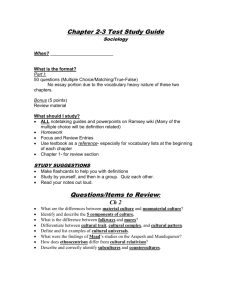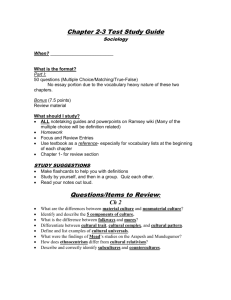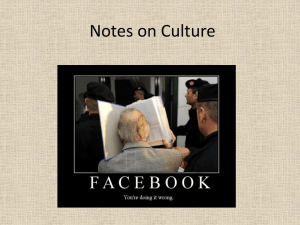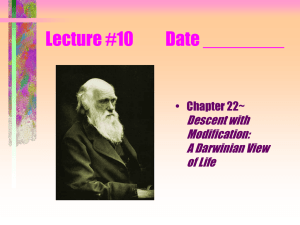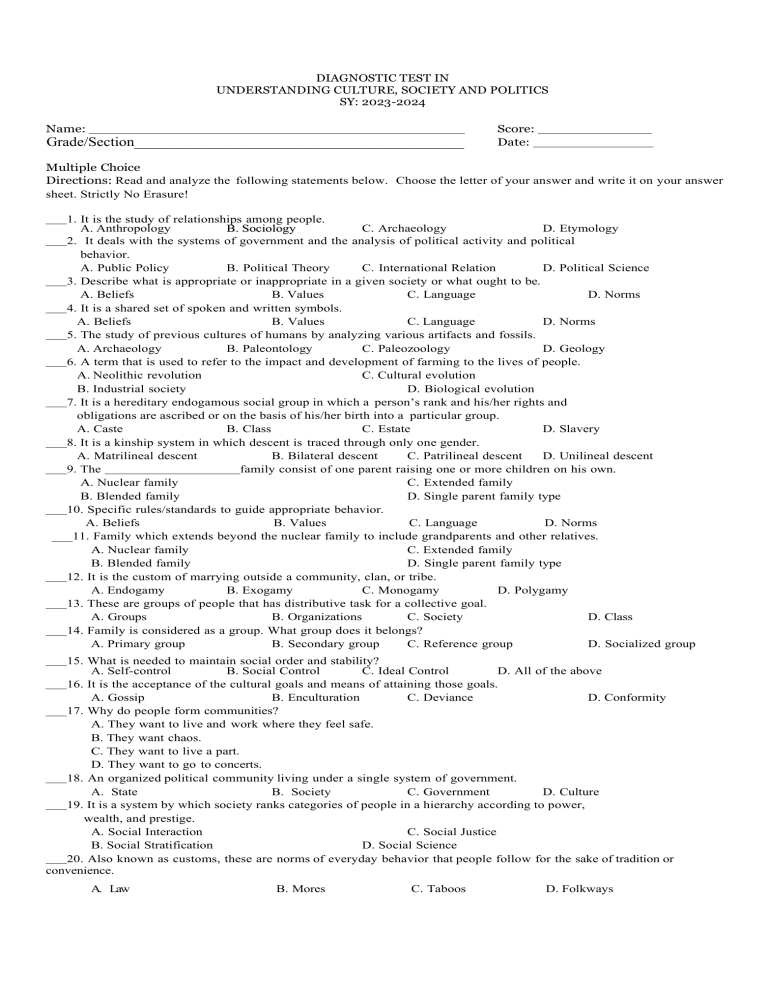
DIAGNOSTIC TEST IN UNDERSTANDING CULTURE, SOCIETY AND POLITICS SY: 2023-2024 Name: Grade/Section___________________________________________ Score: Date: Multiple Choice Directions: Read and analyze the following statements below. Choose the letter of your answer and write it on your answer sheet. Strictly No Erasure! 1. It is the study of relationships among people. A. Anthropology B. Sociology C. Archaeology D. Etymology 2. It deals with the systems of government and the analysis of political activity and political behavior. A. Public Policy B. Political Theory C. International Relation D. Political Science 3. Describe what is appropriate or inappropriate in a given society or what ought to be. A. Beliefs B. Values C. Language D. Norms 4. It is a shared set of spoken and written symbols. A. Beliefs B. Values C. Language D. Norms 5. The study of previous cultures of humans by analyzing various artifacts and fossils. A. Archaeology B. Paleontology C. Paleozoology D. Geology 6. A term that is used to refer to the impact and development of farming to the lives of people. A. Neolithic revolution C. Cultural evolution B. Industrial society D. Biological evolution 7. It is a hereditary endogamous social group in which a person’s rank and his/her rights and obligations are ascribed or on the basis of his/her birth into a particular group. A. Caste B. Class C. Estate D. Slavery 8. It is a kinship system in which descent is traced through only one gender. A. Matrilineal descent B. Bilateral descent C. Patrilineal descent D. Unilineal descent 9. The family consist of one parent raising one or more children on his own. A. Nuclear family C. Extended family B. Blended family D. Single parent family type 10. Specific rules/standards to guide appropriate behavior. A. Beliefs B. Values C. Language D. Norms 11. Family which extends beyond the nuclear family to include grandparents and other relatives. A. Nuclear family C. Extended family B. Blended family D. Single parent family type 12. It is the custom of marrying outside a community, clan, or tribe. A. Endogamy B. Exogamy C. Monogamy D. Polygamy 13. These are groups of people that has distributive task for a collective goal. A. Groups B. Organizations C. Society D. Class 14. Family is considered as a group. What group does it belongs? A. Primary group B. Secondary group C. Reference group D. Socialized group 15. What is needed to maintain social order and stability? A. Self-control B. Social Control C. Ideal Control D. All of the above 16. It is the acceptance of the cultural goals and means of attaining those goals. A. Gossip B. Enculturation C. Deviance D. Conformity 17. Why do people form communities? A. They want to live and work where they feel safe. B. They want chaos. C. They want to live a part. D. They want to go to concerts. 18. An organized political community living under a single system of government. A. State B. Society C. Government D. Culture 19. It is a system by which society ranks categories of people in a hierarchy according to power, wealth, and prestige. A. Social Interaction C. Social Justice B. Social Stratification D. Social Science 20. Also known as customs, these are norms of everyday behavior that people follow for the sake of tradition or convenience. A. Law B. Mores C. Taboos D. Folkways 21. It is where the social group with which and individual does not identify to be part of. A. Out-Group B. Primary Group C. Reference Group D. Secondary Group 22.To allow us do what we want to do. A. To help us realize what we are deserving for liberties and protection. B. To free us from punishment and other free us from punishment whenever we commit mistakes. C. To help us defend ourselves even if we violate the rules. 23. A person or practitioner who studies Anthropology. A. Sociologist B. Psychologist C. Anthropologist D. Archaeologist 24. It refers to an alteration in the social order of a society. A. Social Stratification B. Social Science C. Social Change D. Social Climber 25. All cultures undergo where cultural traits do not remain exactly the same over periods of time. A. Ethics B. Cultural change C. Cultural traits D. Religion 26. Culture is a central concept in anthropology, encompassing the range of phenomena that are transmitted through social learning in human societies. Which of the following statements best describes culture? A. A people’s way of life, including beliefs, customs, food, dwellings, and clothing. B. A vast, treeless plain in the Artic regions with very cold winters, cold summers, and little rain or snow. C. Useful material found in nature, including water, vegetation, animals, and minerals. D. Movement by people from one place to another with intentions of settling in new location. 27. in which an individual’s kin group, or clan membership, is traced through men. A. Matrilineal descent B. Bilateral descent C. Patrilineal descent D. Unilineal descent 28. It is the custom of marrying only within the limits of a local community, clan, or tribe. A. Endogamy B. Exogamy C. Monogamy D. Polygamy 29. Ethnocentrism refers to . A. The tendency to judge other cultures using the standards of one’s own culture. B. The view that some societies are superior to one’s own. C. The co-existence of diverse cultures with equal standing in a society. D. Judging another culture by its own standard. 30. It is achieved by a leader through the process of following established codes and procedures governing the allocation and distribution of power and resources within a society. A. Traditional Authority C. Legal Authority B. Charismatic Authority D. Illegal Authority 31. A form of leadership legitimacy that highlights the right of a leader to rule based on inheritance of the title. A. Traditional authority C. Legal authority B. Charismatic authority D. Illegal authority 32. Which of the following is not an element of culture? A. Food B. Language C. Geography D. Religion 33. If people know what is right and wrong, what will most likely to happen? A. People might avoid doing wrong things instead, do the right things. B. People might continue doing things that makes them happy and satisfied. C. People might avoid only those things that are punishable by law. D. People might change. 34. What will happen if people fail to socialize? A. People will be happy living alone because no one will disturb them. B. People will be learning things that they have not learned before through socialization. C. Learning will be stagnant because a lot can be learned from socialization. D. Learning will be fun because you are discovering it alone. 35. Why do groups consider as “The Heart of Interaction”? A. They share a common set of characteristics. C. They just gather in one place. B. They don’t have the same interests. D. They just form a group with no reason. 36. Mommy and daddy taught their one-year old daughter Raine how to play ABC song with the use of their Lenovo cellphone. Now, Raine can able to open the phone and sing the ABC song. What characteristics of culture is shown in the situation? A. Culture is learned. C. Culture is shared. B. Culture is integrated. D. Culture is symbolic. 37. It is something that is not present in nature but is formed through a process done by man. A. Artifacts B. Civilization C. Democracy D. Neolithic 38. Examines the contemporary application of political concepts such as human rights, equality, peace, and justice. A. Comparative Politics C. Political Science B. Political Theory D. Political Behavior 39. Why is language one of the most important aspects of culture? A. When groups migrate, a shared language helps prevent conflict. B. Language allows people to communicate and provides a sense of identity. C. Unlike other aspects of culture, language does not change. D. Languages can be classified into language families. 40. What are the solutions to human rights violation? A. Let the people do what they ought to do. B. Help in promoting protection to human dignity, human rights, and the common good. C. Help the criminal in promoting protection for themselves and allow them to continue what they do. D. Participate in rallies to voice out your perspectives and opinions in life. 41. It is a branch of political science that aims to provide context to the differences in government and political systems. A. Comparative Politics C. Political Science B. Political Theory D. Political Behavior 42. The set of personnel who manages the affairs of the state in its act of allocating scarce values is called the . A. Territory C. Sovereignty B. People D. Government 43. This is the capacity of a political system to make independent decisions within its territory. A. Territory C. Sovereignty B. People D. Government 44. This is the geographic space in which the sovereignty of a state is exercised. A. Territory C. Sovereignty B. People D. Government 45. It is a political value that is limited in distribution but highly demanded by the populace. A. Power C. Sovereignty B. People D. Government 46. This field inquires on the types of governmental policies and the underlying motivations for their enactment and implementation. A. Public Administration C. Political Science B. Political Behavior D. Public Policy 47. It is the act of violating the prescribed social norms. A. Gossip B. Enculturation C. Deviance D. Conformity 48. It is a small social group whose members share personal and lastingrelationship A. Out-group B. Primary Group C. Reference Group D. Secondary Group 49. These are the rewards or forms of punishment that are formally awarded by an institution such as a government, a council, or an establishment. A. Formal sanctions C. Positive sanctions B. Informal sanctions D. Negative sanctions 50. These are actions or statements that reward a particular behavior, which reinforce its repetition. A. Formal sanctions C. Positive sanctions B. Informal sanctions D. Negative sanctions ****************************************** Prepared By: Subject Teacher Good Luck! ********************************************** 1 b 2 d 3 b 4 c 5 a 6 7 8 9 10 a a d d d 11 c 12 b 13 b 14 a 15 b 16 d 17 a 18 a 19 b 20 d 21 a 22 a 23 c 24 c 25 b 26 a 27 c 28 a 29 a 30 c 31 a 32 a 33 a 34 c 35 a 36 a 37 a 38 b 39 b 40 b 41 a 42 d 43 c 44 a 45 a 46 d 47 c 48 b 49 a 50 c

